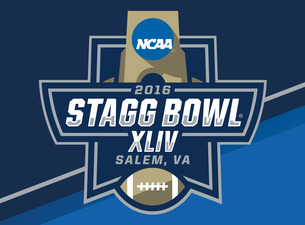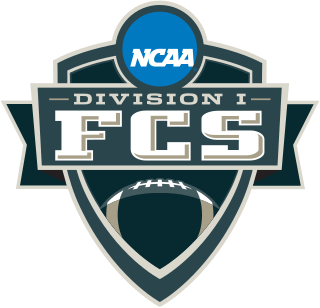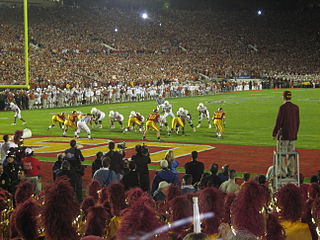
The NCAA Division III Football Championship is an American college football tournament played annually to determine a champion at the NCAA Division III level. It was first held in 1973, as a single-elimination playoff with eight teams. Over the past 50 seasons, the number of participants has grown to 32, with the current bracket size dating from 2005. In 2023, 28 playoff bids went to conference champions via automatic qualification, leaving just four places for at-large selections.

The NCAA Division I Football Championship is an annual post-season college football game, played since 2006, used to determine a national champion of the NCAA Division I Football Championship Subdivision (FCS). From 1978 to 2005, the game was known as the NCAA Division I-AA Football Championship.

In North America, a bowl game, or simply bowl, is one of a number of postseason college football games that are primarily played by teams belonging to the NCAA's Division I Football Bowl Subdivision (FBS). For most of its history, the Division I Bowl Subdivision had avoided using a playoff tournament to determine an annual national champion, which was instead traditionally determined by a vote of sports writers and other non-players. In place of such a playoff, various cities across the United States developed their own regional festivals featuring postseason college football games. Prior to 2002, bowl game statistics were not included in players' career totals. Despite attempts to establish a permanent system to determine the FBS national champion on the field, various bowl games continue to be held because of the vested economic interests entrenched in them.

The BCS National Championship Game, or BCS National Championship, was a postseason college football bowl game, used to determine a national champion of the NCAA Division I Football Bowl Subdivision (FBS), first played in the 1998 college football season as one of four designated bowl games, and beginning in the 2006 season as a standalone event rotated among the host sites of the aforementioned bowls.
The NCAA was without a playoff for the major college football teams in the University Division, later known as Division I-A, during the 20th century. The NCAA recognizes Division I-A national champions based on the final results of polls including the "wire service", FWAA and NFF. The 1964 AP poll continued to rank only ten teams, compiling the votes of 55 sportswriters, each of whom would give their opinion of the ten best. Under a point system of 10 points for first place, 9 for second, etc., the "overall" ranking was determined.
The Associated Press poll provides weekly rankings of the top 25 NCAA teams in one of three Division I college sports: football, men's basketball and women's basketball. The rankings are compiled by polling 62 sportswriters and broadcasters from across the nation. Each voter provides their own ranking of the top 25 teams, and the individual rankings are then combined to produce the national ranking by giving a team 25 points for a first place vote, 24 for a second place vote, and so on down to 1 point for a twenty-fifth place vote. Ballots of the voting members in the AP poll are publicized.
A mythical national championship is national championship recognition that is not explicitly competitive. This phrase has often been invoked in reference to American college football, because the NCAA does not sponsor a playoff-style tournament or recognize official national champions for the Football Bowl Subdivision. The relevant recognition before 1998 came from various entities, including coach polls and media ballots, which each voted to recognize their own national champions, and is similar to the newspaper decision used in early boxing matches. The contrary term would be an undisputed national championship.
The Coaches Poll is a weekly ranking of the top 25 NCAA Division I Football Bowl Subdivision (FBS) college football, Division I college basketball, and Division I college baseball teams. The football version of the poll has been known officially as the US LBM Coaches Poll since 2023.
In the 1968 NCAA University Division football season, the system of "polls and bowls" changed. The Associated Press returned to its pre-1961 system of ranking the Top 20 rather than the Top 10, and voted on the national champion after the bowl games, rather than before. During the 20th century, the NCAA had no playoff for the major college football teams in the University Division, later known as Division I-A.
The 1972 NCAA University Division football season saw the USC Trojans, coached by John McKay, go undefeated and win the national championship as the unanimous choice of the 50 AP panelists. Eighth-ranked in the preseason, the Trojans were narrowly voted No. 1 in the first AP poll, and stayed out front for the rest of the year.
The 1973 NCAA Division I football season was the first for the NCAA's current three-division structure. Effective with the 1973–74 academic year, schools formerly in the NCAA "University Division" were classified as Division I. Schools in the former "College Division" were classified into Division II, which allowed fewer athletic scholarships than Division I, and Division III, in which athletic scholarships were prohibited.

The NCAA Division I Football Bowl Subdivision (FBS), formerly known as Division I-A, is the highest level of college football in the United States. The FBS consists of the largest schools in the National Collegiate Athletic Association (NCAA). As of the 2024 season, there are 10 conferences and 134 schools in FBS.

A national championship in the highest level of college football in the United States, currently the NCAA Division I Football Bowl Subdivision (FBS), is a designation awarded annually by various organizations to their selection of the best college football team. Division I FBS football is the only National Collegiate Athletic Association (NCAA) sport for which the NCAA does not host a yearly championship event. As such, it is sometimes referred to as a "mythical national championship".

The Jacksonville State Gamecocks football program is the intercollegiate American football team for Jacksonville State University (JSU) located in the U.S. state of Alabama. The team competes in the NCAA Division I Football Bowl Subdivision (FBS) as a member of the Conference USA. Jacksonville State's first football team was fielded in 1904. The team plays its home games at the 24,000-seat Burgess–Snow Field at JSU Stadium in Jacksonville, Alabama.
The Humboldt State Lumberjacks football program represented Humboldt State University, known since January 2022 as California State Polytechnic University, Humboldt, in college football and played its home games at the Redwood Bowl in Arcata, California. Humboldt State was a football member of the Great Northwest Athletic Conference in NCAA Division II. Through the 2017 season, the Lumberjacks played 89 seasons and had an all-time record of 402–395–21 (.504).
The 1973 NCAA Division II football season, part of college football in the United States organized by the National Collegiate Athletic Association at the Division II level. The season began in September and concluded with the Division II Championship on December 15 at Hughes Stadium in Sacramento, California. This was the first season for Division II football, which were formerly in the College Division in 1972 and prior.
The 1974 NCAA Division II football season, part of college football in the United States organized by the National Collegiate Athletic Association at the Division II level, began in September and concluded with the Division II Championship on December 14 at Hughes Stadium in Sacramento, California.
The 1973 small college football rankings are rankings of college football teams representing smaller college and university teams during the 1973 NCAA Division II, Division III, and NAIA football seasons. Separate rankings were published by the Associated Press (AP) and the United Press International (UPI). The AP rankings were selected by a board of sports writers, and the UPI rankings were selected by a board of small-college coaches.
The 1982 NCAA Division I-AA Football Championship Game was a postseason college football game between the Eastern Kentucky Colonels and the Delaware Fightin' Blue Hens. The game was played on December 18, 1982, at Memorial Stadium in Wichita Falls, Texas. The culminating game of the 1982 NCAA Division I-AA football season, it was won by Eastern Kentucky, 17–14.









